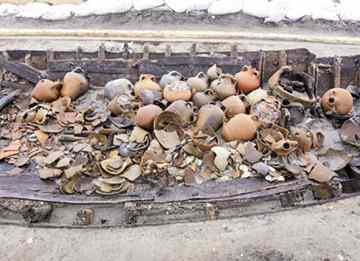The Istanbul Center in Brussels has opened an exhibition featuring artifacts representing 8,500 years of Istanbul’s historical and cultural heritage. The exhibition features interactive multimedia and objects unearthed during Istanbul's Marmaray project excavations, including a unique collection of 34 sunken ships.
 An exhibition currently showing at a Brussels gallery featuring artifacts portraying 8,500 years of Istanbul history has been praised by the city's mayor for protecting its cultural and historical heritage.
An exhibition currently showing at a Brussels gallery featuring artifacts portraying 8,500 years of Istanbul history has been praised by the city's mayor for protecting its cultural and historical heritage.
“This city has a history of 8,500 years. It has traces of various civilizations and has united civilizations just like it unites two continents,” Istanbul Mayor Kadir Topbaş said, adding that the pieces in the exhibition demonstrate the historical span of human habitation in Istanbul.
“Underground Revolution,” is currently being exhibited at the Istanbul Center in Brussels, or ICiB, in conjunction with the Istanbul 2010 European Capital of Culture Agency and was formally opened Tuesday by Topbaş.
The exhibition includes pieces that were unearthed during excavations for the Marmaray project and should be preserved for the future for the sake of humanity, Topbaş said.
“More than 30,000 objects have been found during the excavations, leading us to rewrite the early history of Istanbul. We have spent 22 million euros on the Marmaray excavations. What we want is to exhibit all these things from the Neolithic period, these 8,000-year-old objects in a museum at the station in Yenikapı.”
Origins of the city
One of the most important archaeological excavations in Turkey’s history has resulted from preparations for the Marmaray project – an ambitious engineering venture that will connect the city’s European and Asian shores with a metro line beneath the Bosphorus. Started in late 2004, the excavations have uncovered Neolithic settlements dating back 8,500 years, including a unique collection of 34 sunken ships. The exhibition takes its name from the revolutionary discoveries made during these excavations.
The current exhibition is based on a 2007 display at the Istanbul Archaeological Museum. Since then there have been exciting new finds, including a Neolithic settlement, incorporated into a multimedia interactive display.
Other visual and archival aspects of the exhibition include a computer database maintaining a store of interviews with experts, and real-time webcams showing excavation activity.
"Underground Revolution" has obliged historians and archaeologists to rethink accepted history about the origins of Istanbul, with especially important discoveries having been made in the districts of Yenikapı, Üsküdar and Sirkeci.
The exhibition is intended to emphasize the common cultural heritage of Istanbul and EU member states. It highlights not just the ancient city and the cultural heritage reflected in the span of its human habitation, but also the challenges modern planners face in preserving and incorporating that past into the contemporary city. The main aim of the exhibition is to show important details about Istanbul’s history and to share data that will contribute to the city’s urban planning.
The exhibition is being held in conjunction with a second exhibition, “Bird’s-eye view of Istanbul from 500-year-old maps,” focusing on maps drawn during the 15th and 16th centuries by three well-known cartographers – Schedell, Buondelmonti and Vavassore – along with other work from the Byzantine period extending up to the 20th century.
"Underground Revolution" is being exhibited with the support of the Istanbul Archaeological Museum and Vehbi Koç Foundation. The opening was also attended by Turkish State Minister and chief European Union negotiator Egemen Bağış, as well as senior members of various European institutes and representatives of EU member states residing in Brussels as part of Istanbul 2010 European Capital of Culture festivities.
The exhibition can be visited at the ICiB until March 31, 2011 between 10 a.m. and 5 p.m. weekdays.
Source: Hürriyet Daily News [December 06, 2010]